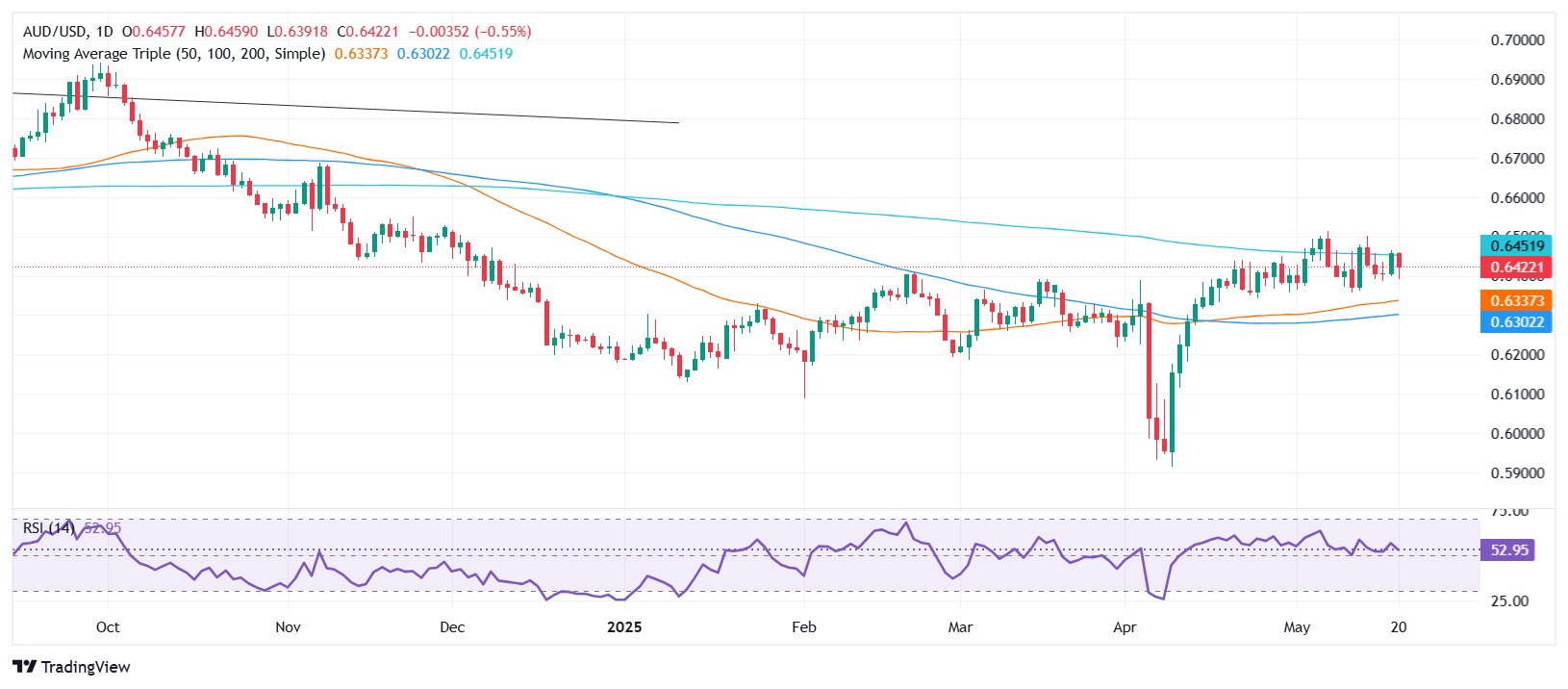AUD/USD hovers above 0.6400 post RBA rate cut, eyes on US Trump tax bill approval

- AUD/USD trades flat at 0.6420 in early Asia after sliding 0.49% on Tuesday as the RBA cut rates to 3.85%.
- RBA opted for a 25 bps cut, citing more balanced inflation risks and heightened global uncertainty.
- Governor Bullock signals flexibility, says RBA is ready to act further if needed, but provides no terminal rate guidance.
The Australian Dollar (AUD) begins the Asian session virtually unchanged against the US Dollar (USD) on Wednesday, following a 0.49% loss in the previous session as the Reserve Bank of Australia (RBA) reduced interest rates. At the time of writing, the AUD/USD trades at 0.6420 flat.
AUD/USD holds steady near 0.6420 after RBA’s 25 bps rate cut; Bullock signals readiness to act as inflation cool
During the North American session, the AUD/USD recovered some ground after reaching a daily low of 0.6391 as the RBA cut rates 25 basis points (bps) from 4.10% to 3.85%. The RBA discussed whether to cut rates by 50 or 25 bps, judging that the risks to inflation had become more balanced while noting that uncertainty in the global economy had increased over the last quarter.
The RBA revealed that it expects trimmed mean inflation to be 2.6% in June 2025. They expect the Aussie economy will grow by 1.8% in June 2025 and 2.2% in 2026.
RBA Governor Michele Bullock said the RBA is ready to take further rate action if needed, acknowledged that inflation has slowed, and expressed confidence in reducing rates. However, she didn’t specify where she sees rates ultimately ending up.
Data from Prime Market Terminal suggests that traders had priced in over 75 bps of easing towards the end of the year.
Newsflows during Tuesday’s US session revealed that traders’ focus is on the approval of US President Donald Trump’s “One Big Beautiful Bill.” The economic docket remained sparse, with a lack of trade agreements and a limited economic calendar.
Nevertheless, some Federal Reserve officials made headlines. St. Louis Fed Alberto Musalem commented that monetary policy is well positioned and added that if inflation expectations de-anchor, the Fed should prioritize bringing inflation down. Cleveland Fed Hammack said that she see a stagflationary scenario, and Atlanta’s Fed Bostic said that the Fed needs to be more certain about the outlook to be comfortable about how monetary policy should shift.
Ahead, the Australian economic docket will feature the release of the Composite Leading Index and the RBA Chart Pack.
AUD/USD Price Chart – Daily
Australian Dollar PRICE This week
The table below shows the percentage change of Australian Dollar (AUD) against listed major currencies this week. Australian Dollar was the strongest against the US Dollar.
| USD | EUR | GBP | JPY | CAD | AUD | NZD | CHF | |
|---|---|---|---|---|---|---|---|---|
| USD | -0.86% | -0.80% | -0.61% | -0.45% | -0.26% | -0.72% | -1.10% | |
| EUR | 0.86% | 0.04% | 0.31% | 0.47% | 0.73% | 0.20% | -0.24% | |
| GBP | 0.80% | -0.04% | -0.04% | 0.43% | 0.69% | 0.16% | -0.28% | |
| JPY | 0.61% | -0.31% | 0.04% | 0.17% | 0.53% | 0.10% | -0.43% | |
| CAD | 0.45% | -0.47% | -0.43% | -0.17% | 0.20% | -0.28% | -0.70% | |
| AUD | 0.26% | -0.73% | -0.69% | -0.53% | -0.20% | -0.52% | -0.94% | |
| NZD | 0.72% | -0.20% | -0.16% | -0.10% | 0.28% | 0.52% | -0.44% | |
| CHF | 1.10% | 0.24% | 0.28% | 0.43% | 0.70% | 0.94% | 0.44% |
The heat map shows percentage changes of major currencies against each other. The base currency is picked from the left column, while the quote currency is picked from the top row. For example, if you pick the Australian Dollar from the left column and move along the horizontal line to the US Dollar, the percentage change displayed in the box will represent AUD (base)/USD (quote).
